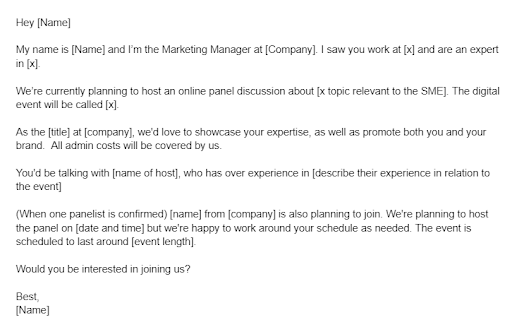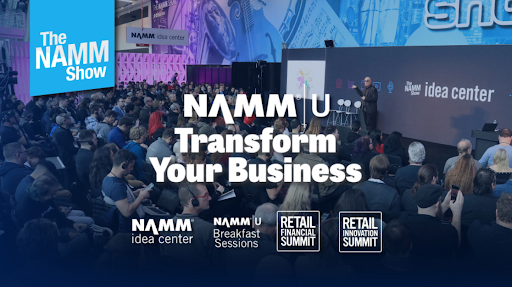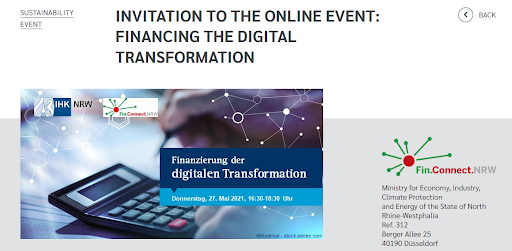SEO
Influencers Drive Global B2B Content Marketing Success

With the mountain of competition in B2B, establishing trust with potential buyers is no easy feat.
Unlike in ecommerce, where transactions are typically swift, and purchases are at far lower prices, B2B sales cycles are lengthier and involve much higher stakes.
With endless opportunities to choose from, community has become more crucial than ever, as people search and check social media but ultimately rely on trusted peers for advice when making important business decisions.
So how can B2B businesses ensure their content stands out and gets noticed – and most importantly, trusted – by their target audience?
This is where influencers, or subject matter experts (SMEs) in the B2B realm, play a pivotal role – particularly in the context of expanding to international markets that speak multiple languages.
By harnessing the reach and reputation of well-known SMEs in the local markets, B2B companies can amplify their international content marketing efforts, ensuring that their message resonates with diverse international audiences.
Over time, SME collaborations enable B2B companies to cultivate a strong community around their brand, which then drives inbound leads and growth across international markets.
Why Involving Local Influencers & SMEs In International B2B Content Marketing Campaigns Is Crucial
Extensive research plays a hefty role in the B2B buying process, in that:
- B2B buyers complete up to 70% of their research prior to even contacting a sales team.
- 87% of B2B buyers say online content has a major or moderate impact on vendor selection.
- 78% of B2B referrals create viable customer leads for the business.
What do all three of those points have in common?
B2B buyers are looking for a trustworthy source to confirm information found during their research.
As such, partnering up with SME influencers is key to building up this crucial brand trustworthiness, especially if you’re a global brand expanding into diverse international markets worldwide.
In fact, up to 86% of B2B brands have reported some measure of success with highly targeted influencer marketing.
But selecting the relevant influencers for the right market is key for content to resonate with local target audiences.
For example, a highly knowledgeable SME from New York City is unlikely to have much sway or influence if you’re targeting customers in Tokyo, on the other side of the world.
This is because:
- An English-speaking influencer has little effect on a primarily Japanese-speaking audience.
- Perceptions towards B2B products and services vary by location because buyers’ needs differ by region.
- Cultural tendencies of buyers in niche markets have significant sway over purchase decisions.
- If influencers lack shared cultural values with the local target audience, their recommendations will fall flat on that audience.
How To Identify And Build Relationships With Local B2B Influencers And SMEs
So, how do you identify the right SME collaboration to expand the authority of your own business in a new market? And how can you build a relationship with them in order to incentivize the SME to collaborate with you?
Let’s now take a deep dive into the process.
Step 1: Research People Who Matter To Your Local Target Audience
It all starts with researching who your audience cares about. A free tool like SparkToro is one of the easiest ways to get started.
Based on your search filter, SparkToro identifies who your target audience follows and trusts as a source of credible information.
You can then curate lists of relevant SMEs for the market you’re looking to expand to, which should ideally also include lesser-known yet still highly credible SMEs whose audiences tend to be more engaged.
To give you a concrete idea, here’s an example of a SparkToro search for a company that provides consulting services and a SaaS tool for document automation. Its goal is to expand into the German market.
I set the filter for “my audience frequently talks about,” typed in “document automation,” and selected Germany for the location.
SparkToro then summarizes the list of influencers, websites, and lesser-known destinations that earn engagement with that buying audience:
In this case, there is a mix of English-language and German-language influencers and relevant publications. Ideally, you’ll want to focus on gaining credibility within the local language, so SparkToro is the just starting point.
You’ll then need to dig deeper into what and who is relevant to contact, as well as invest time into building relationships with SMEs, depending on the relevance of their followers.
Step 2: Identify Ways To Involve Them That Require Little Effort On Their Behalf
Once you’ve conducted the research and identified the relevant SMEs to collaborate with within the local market, the next step is to determine how best to approach them.
Keep in mind that the most effective outreach strategy is one that makes it as easy as possible for SMEs to see the value in a partnership. Don’t just beg for their time and offer up nothing in return.
For example, you can offer for them to attend a panel discussion on a highly relevant topic for their industry and local market.
Here’s an example of how you might contact an SME for collaboration via LinkedIn or email:
 Image created by author, May 2023
Image created by author, May 2023This type of message prompts a response from SMEs for a few reasons:
- They know they’ll be advertised without paying.
- They don’t have to spend tons of time preparing, especially as it’s a panel discussion, so their time commitment is minimal.
- They have a chance to network with and learn from well-known people within their industry, bringing back benefits for their personal and company brands.
Step 3: Nurture Relationships And Provide Ongoing Value
Finally, once you connect with an SME and convince them to collaborate together, you want to maintain and deepen that working relationship, because this increases the chance of future collaboration opportunities.
In fact, if the relationship becomes a strong one, the influencer is likely to refer your B2B business to their network, or even come back to you themselves as a customer.
This is actually the long-term strategic value of such partnerships because it directly impacts high-quality inbound lead generation.
Ways to strengthen ongoing relationships with SMEs include:
- Regularly engaging with their own content, such as by commenting on or sharing their updates to support their efforts and keep your brand top-of-mind as they continue producing new content for their own audience.
- Offering to mention them and/or link to their content in future content you create.
- Offering to meet up for a coffee at in-person conferences and get to know them.
- Develop a partner referral agreement so you both can refer potential customers and generate inbound leads.
- Continuing to collaborate on marketing efforts together where both brands are promoted.
How To Apply B2B Influencer And SME Data To Both Global & Local Content Marketing Efforts
Now that you’ve got the process in mind, what are some direct examples of how to apply SME collaborations across content marketing efforts?
I’ll cover this in further detail in the below section for various types of content marketing applied both globally and locally.
Panel Discussions & Co-marketing Webinars
As mentioned in the message example from the how-to section above, panel discussions are a highly effective method for beginning engagement with SME influencers because they require little to no preparation time for the participants.
Plus, in nearly every market, industry titans enjoy conversing with their fellow experts to share insights and recommendations to listening audiences.
Panel discussions can be both live or virtual events, but regardless of the format, they’re a great resource that elevates the authority of your own brand to your audience due to the SMEs who attend.
Global Approach
To give an example that works globally, here’s an example of a live panel discussion about the secrets of successful influencer marketing and content creation.
 Screenshot from The NAMM Show, May 2023
Screenshot from The NAMM Show, May 2023This topic applies globally because it’s a question that brands all over the world struggle to answer.
When applied to your own content strategy, ideally, the SMEs invited to such a discussion should come from multiple markets, particularly those that you plan to expand into internationally.
An important point to note: global in-person events should be treated as annual affairs.
Creating a one-time event that pools together the biggest influencers in an industry is a special occasion, so it’s not something to do regularly, as they come with higher resource costs for both you and the participants.
Local Approach
When applying the concept of a panel discussion within a local market, you can go much smaller in scale and ideally virtually, which provides more flexibility to create recurring panel discussions throughout the year.
Start by selecting a topic that is relevant to the local market and the target audience.
For instance, if you’re an IT company and are targeting German businesses, you could host a panel discussion on “How German Companies Can Finance Digital Transformation” (but in the German language equivalent).
Then, use your SparkToro account to identify the biggest German influencers in the IT industry and invite them to participate in a special panel discussing tips to scale digital transformation across Germany.
Here’s an example from a similar event:
 Screenshot from germany-finance.com, May 2023
Screenshot from germany-finance.com, May 2023By hosting a panel discussion with local SMEs who speak German, you present valuable insights to your buying audience in Germany in that localized setting and context.
You can then deepen relationships with key players that your target audience already follows, and follow up by creating localized content that resonates with those same local market buyers to guide them further on their buying journey with your brand.
Whitepapers
Whitepapers are one of the most valuable resources in B2B content marketing when they include original data and information that isn’t available anywhere else.
You can make whitepapers with unique data by gathering information from SMEs.
Plus, SMEs typically appreciate being cited in whitepapers because their personal brand is attached to that in-depth report, which automatically elevates their own standing and credibility with their followers.
Global Approach
A global approach to this strategy is to select a topic that has a more universal appeal.
Again, digital transformation is a subject that impacts brands all over the world, so creating an in-depth whitepaper on the topic has global appeal – but only if it’s backed with information from highly credible SMEs.
A great example is the “Data and Digital Transformation: Insights From Shipping Leaders” whitepaper created by S&P Global Market Intelligence. It includes insights from six of the leading SMEs from various international markets.
In the same manner that S&P Global Market Intelligence has done here, ensure in your content strategy that the SMEs included for global content also appeal to your international target markets.
Local Approach
When it comes to the local approach, the main difference from the global is that you want to target the analysis and present the whitepaper findings within the context of a regional point of view.
Paralleling the global subject matter, you can create your own whitepaper explaining the ideal digital transformation journey for the shipping industry in one particular market.
As an example, let’s use the Port of Los Angeles, which continues to struggle with supply chain issues in the aftermath of the COVID-19 pandemic.
Your whitepaper can answer many of the questions that have ground supply chain businesses in Los Angeles to a halt by inviting SMEs with experience managing those ports to contribute information.
Although the example is in English, the concept applies across markets that speak other languages, too.
With a more localized approach, you gain specific insights to publish in your content and establish your brand as a thought leader in that particular market.
This also increases your opportunity to build relationships with key local players and generate leads and referrals from the target buying audience.
Podcasts
Podcasts are a heavily growing medium for B2B content marketing.
By collaborating with influencers and SMEs on a podcast, you can tap into their expertise and reach new audiences through audio content that millions of people stream throughout their busy days.
Global Approach
When building your podcast, start by identifying global influencers and SMEs with a strong following in your industry.
For example, if you’re an HR consulting company, you could collaborate with a senior HR specialist.
Choose a topic that would be of interest to both the global audience and the local influencers.
For instance, you could create a podcast episode on “The Future of Work in a Post-Pandemic World.”
You can follow examples from the HubSpot team that manages their podcast, “Culture Happens.” In this particular episode, they discuss the future of remote work.
You can even reach out to those same presenters and invite them to participate as guests on your own podcast discussing the topic in a similar but unique manner.
Through this collaboration, you tap into their wider audience, build your brand credibility, and generate new leads and referrals through your podcast.
Local Approach
The localized podcast approach involves identifying SMEs who have followings in particular markets and that speak the language that your business intends to target.
For instance, to localize the podcast example from above for France, you could do an episode around “Streamlining New Employment Regulations Around Remote Work in France” and invite an HR specialist from the French market to speak about their experience with handling these changes.
This helps you build a loyal following in concentrated local markets, which translates into higher volumes of inbound leads that grow your business internationally.
Collaborate with SMEs to Win and Global and International Content Marketing
In the highly competitive world of B2B, where trust and reputation are paramount, leveraging the expertise and influence of SMEs is a powerful strategy.
As you strive to make your mark in international markets, remember that collaborations with trusted and local influencers can help your content shine, resonate, and ultimately drive success in your B2B endeavors.
Over time, these partnerships with SMEs not only help you create valuable and trusted content but also cultivate a strong community around your brand.
By providing informative and practical content, you can position yourself as a B2B industry thought leader and trusted source of knowledge.
And most importantly, by tapping into the networks of global and local influencers, B2B businesses can drive inbound leads and foster growth in international markets.
More resources:
Featured Image: Chay_Tee/Shutterstock

















